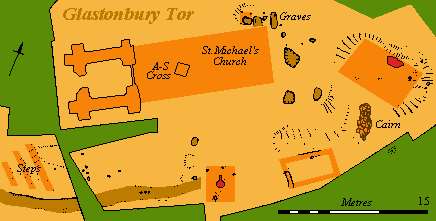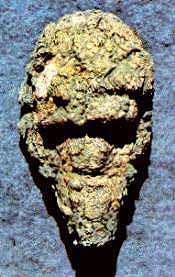
EBK Home
Kingdoms
Royalty
Saints
Pedigrees
Archaeology
King Arthur
Mail David
GLASTONBURY TOR
Queen Guinevere's Prison?
The Tradition: In Caradog of Llancarfan's Life of St. Gildas, written around 1130, can be found a story telling of St. Gildas' intervention between King Arthur and one King Melwas of the "Summer Country". Melwas had abducted Guinevere to his stronghold at Glastonbury, where Arthur soon arrived to besiege him. However, Gildas, ever the peacemaker, persuaded Melwas to release the Guinevere and the two monarchs soon reconciled their differences. The story can also be found in a Welsh poem known as The Dialogue of Melwas and Gwenhwyfar, the surviving manuscripts of which date from the 16th century. Chrétien is best known for his use of the episode in his Lancelot story, but here the Knight was said to have killed Melwas (alias Meleagaunce), while St. Gildas is never mentioned.
 Modern
Archaeology:
Excavations on Glastonbury Tor, undertaken between 1964 and 1966, revealed
evidence of Dark Age occupation around the later Medieval church of St.
Michael. The site was entered via roughly cut steps to the West. Remains
of structures were slight, though the beam slots of one wooden building
were uncovered, and there were post-holes of others. Two further
structures were indicated by surviving hearths: one of which was an
intriguing metalworker's furnace complete with bellows inlet. Alongside
what has been interpreted as a small wooden latrine building, were
discovered two 6th century teenage graves orientated North-South. A large
empty cairn lay not far away. A vast amount of animal bone was recovered,
possibly indicating feasting; and twelve sherds of imported 6th century
Mediterranean amphorae. The most interesting find was a small cast bronze
head possibly from a staff or bucket escutcheon.
Modern
Archaeology:
Excavations on Glastonbury Tor, undertaken between 1964 and 1966, revealed
evidence of Dark Age occupation around the later Medieval church of St.
Michael. The site was entered via roughly cut steps to the West. Remains
of structures were slight, though the beam slots of one wooden building
were uncovered, and there were post-holes of others. Two further
structures were indicated by surviving hearths: one of which was an
intriguing metalworker's furnace complete with bellows inlet. Alongside
what has been interpreted as a small wooden latrine building, were
discovered two 6th century teenage graves orientated North-South. A large
empty cairn lay not far away. A vast amount of animal bone was recovered,
possibly indicating feasting; and twelve sherds of imported 6th century
Mediterranean amphorae. The most interesting find was a small cast bronze
head possibly from a staff or bucket escutcheon.
 Possible
Interpretations: The
traditional religious nature of the Tor's summit, shown today by the
surviving tower of St. Michael's Church, might suggest a Dark Age
monastery had been uncovered there. The church dedication might, in fact,
indicate a pagan religious site later converted to Christianity (thus the
Devil was conquered by St. Michael). The bronze mask could have been
from a Bishop's Crosier. Indeed, St. Patrick is said to have discovered an
abandoned hermitage here in the late 5th century. However, this latter
reference is highly dubious and there is little else to recommend such an
interpretation. Would such a monastery have been founded so near to the
great Abbey below? Graves orientated North-South are unlikely to be found
in a Christian context, while metalworking and feasting, though undertaken
on monastic sites, would certainly fit a secular stronghold better. The
capital of the Sub-Kings of Glastenning is perhaps indicated. The
reference to Melwas being Ruler in the Summer Country ("in aestiva
regione") is, no doubt, a late description of the Kingdom of
Glastening transformed into the Saxon Somerset.
Possible
Interpretations: The
traditional religious nature of the Tor's summit, shown today by the
surviving tower of St. Michael's Church, might suggest a Dark Age
monastery had been uncovered there. The church dedication might, in fact,
indicate a pagan religious site later converted to Christianity (thus the
Devil was conquered by St. Michael). The bronze mask could have been
from a Bishop's Crosier. Indeed, St. Patrick is said to have discovered an
abandoned hermitage here in the late 5th century. However, this latter
reference is highly dubious and there is little else to recommend such an
interpretation. Would such a monastery have been founded so near to the
great Abbey below? Graves orientated North-South are unlikely to be found
in a Christian context, while metalworking and feasting, though undertaken
on monastic sites, would certainly fit a secular stronghold better. The
capital of the Sub-Kings of Glastenning is perhaps indicated. The
reference to Melwas being Ruler in the Summer Country ("in aestiva
regione") is, no doubt, a late description of the Kingdom of
Glastening transformed into the Saxon Somerset.
